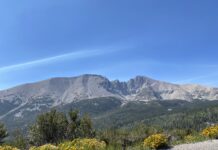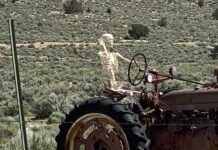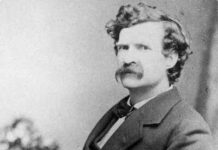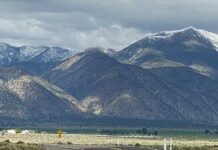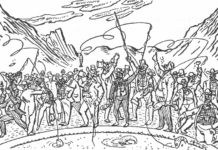Last year Robin and I spent several magical days following Sam Clemens around Paris and when the opportunity came to come back again, I decided to see what else Nevada people have been up to here since Sam came to town in 1867.
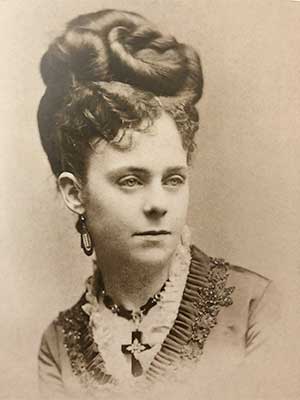
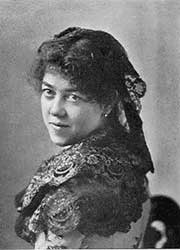 I discovered, though, that Nevada’s impact on Paris was mostly over by the end of the 19th century, and that the two Nevadans responsible for most of it were women, one from Virginia City, the other from Austin.
I discovered, though, that Nevada’s impact on Paris was mostly over by the end of the 19th century, and that the two Nevadans responsible for most of it were women, one from Virginia City, the other from Austin.
These were interesting and remarkable women, and they had great successes in Paris — Marie Louise Mackay (left) was a bright star in the social life of the cité (after failing in NYC even though her husband was one of the richest men in the world. hint: No Irish Need Apply), and Emma Nevada (right) was an internationally acclaimed opera singer. They contributed to Paris’ “Belle Epoque” (1879-1914), but most of what makes them interesting happened before they got here. [Read about their earlier years here]
They didn’t leave anything behind in Paris except their addresses (they both moved on to England). Louise lived at 9 rue de Tilsitt, a 5-story mansion on one of the streets circling L’Etoile, with the Arc de Triomphe in her back yard. Emma lived a long haul up the Avenue de Wagram, one of those streets that radiate like spokes away from L’Etoile, at #121. Once you’ve laid eyes on the buildings there’s not much else to do except find a convenient cafe and call for a Côte de Rhône.
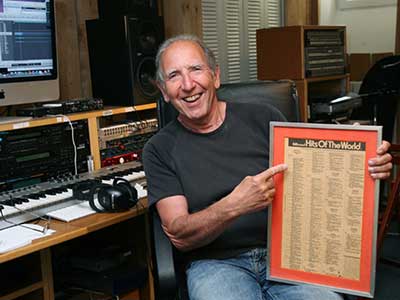 And then we met an ex-Nevadan who lives here, and so one afternoon we took the Metro to the rue Vasco de Gama residence of Jack Armstrong and his wife Catherine. Once upon a time he was the Carson City correspondent for the Associated Press — until he decided to become a Foreign Correspondent, resigned, and moved to Paris. Here he got a job writing photo captions at the old International Herald-Tribune, and not long after moved on to United Press International where his job title was indeed Foreign Correspondent. He wasn’t yet 25.
And then we met an ex-Nevadan who lives here, and so one afternoon we took the Metro to the rue Vasco de Gama residence of Jack Armstrong and his wife Catherine. Once upon a time he was the Carson City correspondent for the Associated Press — until he decided to become a Foreign Correspondent, resigned, and moved to Paris. Here he got a job writing photo captions at the old International Herald-Tribune, and not long after moved on to United Press International where his job title was indeed Foreign Correspondent. He wasn’t yet 25.
Three years later he was working for Radio Luxembourg as a part-time weekend dj, and from there worked himself into the heart of the music business.
He learned the art of producing records, established a music publishing company and began working with French composer/singer David Christie, (nom de plume James Bolden). They sold more than 50 million units with their songs.
Robinson then went on to produce a ton of music, including a string of songs at the top of the European charts, nine songs for Grace Jones and “Dancing In The Moonlight“, a massive hit in The USA with the group King Harvest. Now he’s writing the libretto for “Walking the Dogs“ a musical comedy being developed for the London stage.
That’s a splendid ride from Carson City, but when I asked him about other traces of Nevada we could find in Paris he drew a blank. To be fair, he was a Seattle guy, not long out of college, only in Carson City for seven months and so wasn’t much sensitized to Nevada after he arrived here.
We stay in the Marais — that part of it between the Seine and the rue de Rivoli, centered loosely on the Village St. Paul — because it is so marvelously old. Just down the street to the left is an ancient church from which one of the Crusades set out for the Holy Land and a section of the wall that once enclosed the cité. And our quiet neighborhood is surrounded by the modern cité. This puts everything in the central cité within walking distance, and walking through Paris provides the same sense of wonder as gazing at the Toiyabes, but noisier.
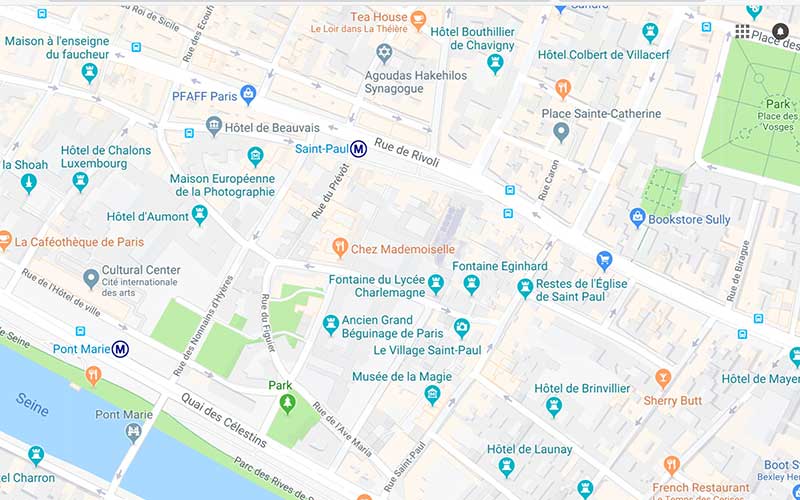
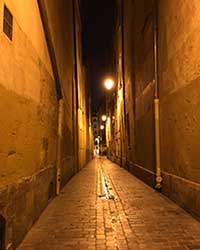 From our little rue we take a turn and walk a loooong block down a narrow street, the rue du Prévôt — for piétons only, too tight a fit for cars — to the rue de Rivoli,
From our little rue we take a turn and walk a loooong block down a narrow street, the rue du Prévôt — for piétons only, too tight a fit for cars — to the rue de Rivoli, 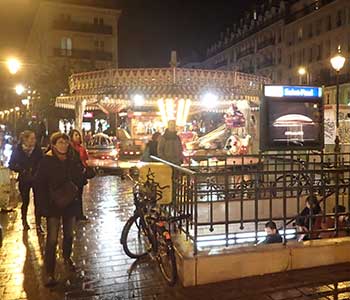 where this medieval passage gives out onto the busy modern city, thronged with people, busy with traffic, buses lumbering by, one of the busiest shopping streets in Paris.
where this medieval passage gives out onto the busy modern city, thronged with people, busy with traffic, buses lumbering by, one of the busiest shopping streets in Paris.
There’s a Metro station here — St. Paul (on the 1) — with an escalator that brings people up from underground in a constant parade, and a stairway that swallows down just as many. There’s a news stand were you can get all the French papers, plus the New York Times, and if it’s raining as it is just now, an umbrella. There are three police with automatic weapons (not always, but several times a week) — and there’s even a merry-go-round! This corner will always be the living heart of the cité for us!
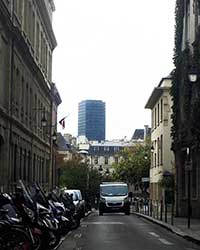 And if we walk in the other direction we’re in the Village St. Paul, two or three blocks from the river on quiet medieval streets. No sense of the city surrounding this ancient urban oasis except here and there a glimpse from afar, like the one from the restaurant ten steps from our front door — the Tour Montparnasse. You might almost be looking at the moon.
And if we walk in the other direction we’re in the Village St. Paul, two or three blocks from the river on quiet medieval streets. No sense of the city surrounding this ancient urban oasis except here and there a glimpse from afar, like the one from the restaurant ten steps from our front door — the Tour Montparnasse. You might almost be looking at the moon.
But even this teeming boulevard in one of the greatest cities in the world is part of a local neighborhood. People don’t just do recreational shopping here. There are grocery stores rather like ours (with lots of little differences), three within a few steps of the rue du Prévôt’s opening onto the busy boulevard, and a Monoprix Supermarket toward the Place de la Bastille about three blocks away.
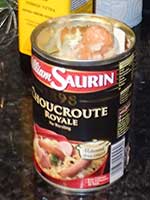 I mentioned little differences, let this be an example: I bought a can of saurkraut (Choucroute Royale) to accompany a sausage that had come into my possession (Robin was away at Lyon). If there’s an Imperiale version it must have two weenies in it. You can’t imagine how surprised I was when I opened the can. At least it wasn’t a thumb.
I mentioned little differences, let this be an example: I bought a can of saurkraut (Choucroute Royale) to accompany a sausage that had come into my possession (Robin was away at Lyon). If there’s an Imperiale version it must have two weenies in it. You can’t imagine how surprised I was when I opened the can. At least it wasn’t a thumb.
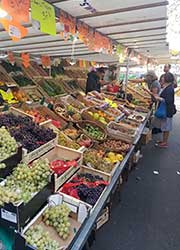 We go to these stores for routine household stuff, and to the street Markets for the fresh food so invitingly presented. When the weather turned cold, which it did after we’d been here a few days, we shopped at the open markets for écharpes, chapeaus and gants, for ourselves and for some of the gifts we’ll bring home.
We go to these stores for routine household stuff, and to the street Markets for the fresh food so invitingly presented. When the weather turned cold, which it did after we’d been here a few days, we shopped at the open markets for écharpes, chapeaus and gants, for ourselves and for some of the gifts we’ll bring home.
A walk to the market might take half an hour, shopping most of another hour at least, and then the walk back, perhaps with a stop along the way for a glass of Côte de Rhône or a nice Bordeaux, and to let the world walk on by. When we set out again we pass any number of landmarks — that’s not extraordinary, you can walk by landmarks almost anywhere in this part of the cité: Place des Vosges! Rue des Rosiers! Les Halles! Centre Pompidou!
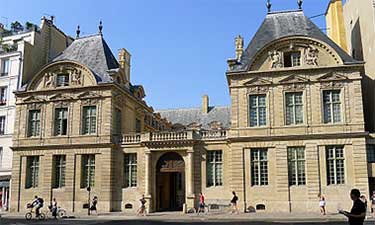 We like strolling past the Hôtel Sully (and into the Place des Vosges). This was once the grandest and most modern structure in Paris, constructed over six years, completed in 1630. When Baron Haussmann was remaking Paris he made sure to spare it.
We like strolling past the Hôtel Sully (and into the Place des Vosges). This was once the grandest and most modern structure in Paris, constructed over six years, completed in 1630. When Baron Haussmann was remaking Paris he made sure to spare it.
The grocery stores carry wine, but if you’re serious about it you’ll find three wine shops within one long block, one of them named Nicolas. The French system seems to favor this friendly practice: there’s also a boulangerie named Paul and cafes run by Richard scattered all over town. They’re all chains.
Permanent Wave in Paris
|
If you’re not familiar with French wines, here’s a quick guide. Good wine is very very cheap. Very good wine is very cheap. And very very good wine is cheap. Trés bon!
Need I say that restaurants abound, and spill out into the streets in all weather? And that they are an advertisement for the generous sense of humanity that the cité represents to us? Well, they are.
We especially liked Chez Mademoiselle and Pinot Grigio in our neighborhood, Le Petite Bofinger on the rue de Bastille has the best Croque Monsieur we’ve found since the street machines were outlawed, and the frites are as good as the ones they make at the International in Austin. Its parent Bofinger across the rue at #7 is our choice for the glamor meal. I felt positively Napoleonic as we clinked our glasses. One more? Au Bougnat, at 26 rue Chanoinesse on the Ile de la Cité where Paris was born. Its antiquity is palpable, and the chef is an artiste. And one more: Au Pied de Cochon within a few steps of Les Halles [hint: boeuf tartare].
A few glimpses of the cité —
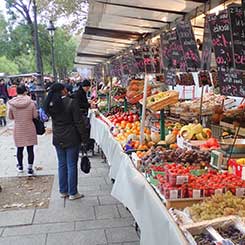
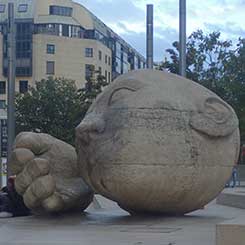
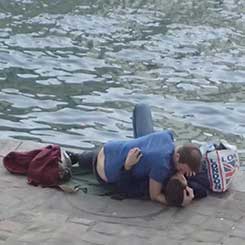
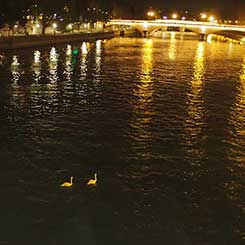
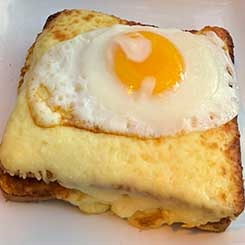
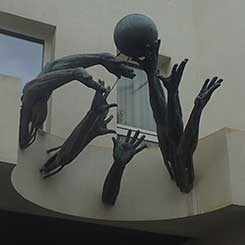 A word of warning: there are a number of Basque Restaurants in Paris and none of them are anything at all like the Martin Hotel in Winnemucca or the JT in Gardnerville or any other Basque place in the state. Our beloved Basque dining halls are named for their clientele, the sheepherders who came in from months with the sheep.
A word of warning: there are a number of Basque Restaurants in Paris and none of them are anything at all like the Martin Hotel in Winnemucca or the JT in Gardnerville or any other Basque place in the state. Our beloved Basque dining halls are named for their clientele, the sheepherders who came in from months with the sheep. 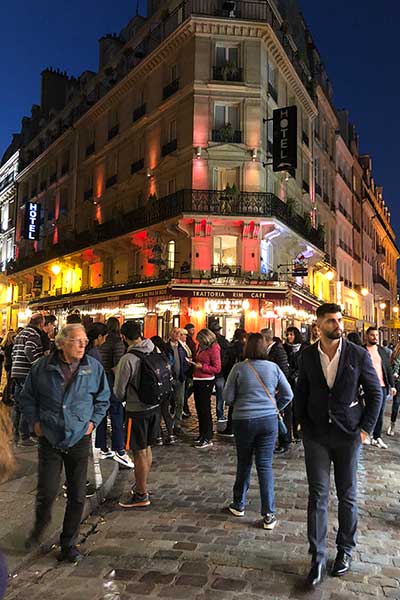 The Basque restaurants here are named for the cuisine that they serve, which is the food Basque people eat in their homeland. You can get a nice steak au poivre, but they also offer things that turn out to be warm little bags of guts.
The Basque restaurants here are named for the cuisine that they serve, which is the food Basque people eat in their homeland. You can get a nice steak au poivre, but they also offer things that turn out to be warm little bags of guts.
Night Life isn’t our strong point but we liked the jazz we heard on a previous visit and we make a point of hearing more of it. At home we’ll walk barefoot in the dark across a floor sprinkled with Legos to catch Sourdough Slim. Here we’ll walk over to the river, along the Quai des Célestines to the Pont Marie and stroll over to the Isle St. Louis, keep going across it to the pont Louis Phillippe and all the way over to the Left Bank.
Then we turn right and continue along the river past Shakespeare & Co. to the Boulevard St. Michel. There we take a left a short block to the rue de la Huchette where we turn left again, and then a right on rue de la Harpe to number 51: Monk La Taverne de Cluny. On Sunday nights Christophe Brunard and his son Julien play here [hint: nobody comes to Monk for the food, but the music is delicious]. Afterward we float back over more or less the same route, past Notre Dame all lit up, into the medieval maze of narrow curving streets.
We’ll be floating all the way home in another few days.
Editor’s Choice —
|
Overheard at the Canvas Cafe in Virginia City: “Here’s the trouble with women, Phil: they’re too much like men.”
Five Years Ago in the NevadaGram — A Call from Joe
|
|
For an excerpt, click the cover. |
I hadn’t heard from Joe for two or three years, and it was four years since I’d laid eyes on him at his Rio De Janeiro penthouse.
For those readers younger than 40, Joe Conforte was the hustler/trickster/entrepreneur who, with his wife Sally Burgess, transformed the Mustang Ranch from a broken down shack in the desert into an unofficial National Monument. It was the first licensed brothel in the USA, famous around the world, and he did it with all the cards stacked against him, with every lawman in the state eager to bring him down.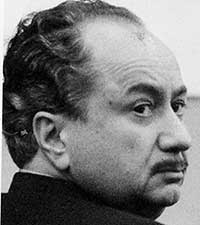
They put him in prison, they made him run for the border, they burned him out — and Sally too when he was in prison — but each and every time, he came back stronger than before. Today he’s living like a king in Rio on the proceeds from his Nevada life.
[ Our bookstore is closed temporarily, but we do have a small number of Joe’s book, both hard cover and paperbound. Send an email for details ]
Ten Years Ago in the NevadaGram — Mark Twain in Hawthorne
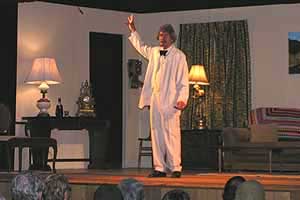 On November 22 Mark Twain performed in Hawthorne for the first time in history, before a packed house at the old USO building, now the Convention Center.
On November 22 Mark Twain performed in Hawthorne for the first time in history, before a packed house at the old USO building, now the Convention Center.
It wasn’t the original Mark Twain, of course — Hawthorne didn’t exist when Sam Clemens came to Aurora, 15 miles to the southwest, as a hopeful gold miner in 1861. For that matter Mark Twain didn’t exist then either — the letters that Clemens sent from Aurora to the Territorial Enterprise in Virginia City were signed Josh.
 By the time Hawthorne was established as a division point on the Carson & Colorado Railroad in 1881, Sam Clemens was firmly established as Mark Twain, living back east and revered as the author of Innocents Abroad, The Adventures of Tom Sawyer, Huckleberry Finn and other hugely popular writings.
By the time Hawthorne was established as a division point on the Carson & Colorado Railroad in 1881, Sam Clemens was firmly established as Mark Twain, living back east and revered as the author of Innocents Abroad, The Adventures of Tom Sawyer, Huckleberry Finn and other hugely popular writings.
 So this was Mark Twain’s first appearance in Hawthorne, courtesy of McAvoy Layne, and the town turned out in force to attend. They packed the theater — extra chairs were hurriedly gathered and set in place — and were treated to his reminiscenses of steamboating on the Mississippi:
So this was Mark Twain’s first appearance in Hawthorne, courtesy of McAvoy Layne, and the town turned out in force to attend. They packed the theater — extra chairs were hurriedly gathered and set in place — and were treated to his reminiscenses of steamboating on the Mississippi:
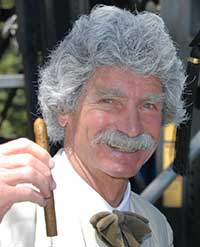 “Every tumblerful of Mississippi River water holds nearly an acre of land in solution. I got this fact from the bishop of the diocese. If you will let your glass stand half an hour, you can separate the land from the water as easy as Genesis; and then you will find them both good: the one good to eat, the other good to drink. The land is very nourishing, the water is thoroughly wholesome.
“Every tumblerful of Mississippi River water holds nearly an acre of land in solution. I got this fact from the bishop of the diocese. If you will let your glass stand half an hour, you can separate the land from the water as easy as Genesis; and then you will find them both good: the one good to eat, the other good to drink. The land is very nourishing, the water is thoroughly wholesome.
“The one appeases hunger; the other, thirst. But the natives do not take them separately, but together, as nature mixed them. When they find an inch of mud in the bottom of a glass, they stir it up, and then take the draught as they would gruel. It is difficult for a stranger to get used to this batter, but once used to it he will prefer it to water. This is really the case. It is good for steamboating, and good to drink; but it is worthless for all other purposes, except baptizing.”
15 Years Ago in the NevadaGram — Winnemucca and Austin
The only disappointment of my recent visit to Las Vegas was that Hofbrauhaus Las Vegas was not yet open.
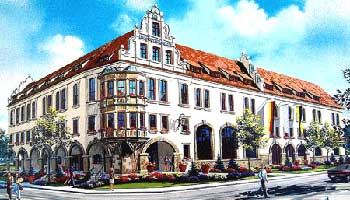 The $12 million, enclosed beer garden, a replica of the famous one in Munich, Germany, was supposed to have opened across Harmon Avenue from the Hard Rock Cafe in October. The structure is to have a 45-foot ceiling and accommodate 800 beer drinkers gulping down the authentic German suds from authentic German steins while listening to authentic German oom-pah bands. Can you understand my sulky mood? Can you feel my pain?
The $12 million, enclosed beer garden, a replica of the famous one in Munich, Germany, was supposed to have opened across Harmon Avenue from the Hard Rock Cafe in October. The structure is to have a 45-foot ceiling and accommodate 800 beer drinkers gulping down the authentic German suds from authentic German steins while listening to authentic German oom-pah bands. Can you understand my sulky mood? Can you feel my pain?
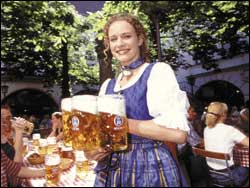 But the local people were not completely discouraged, as the proprietors, when they realized they would not be open in time for Oktoberfest, erected a 1,000-seat tent in the parking lot at Terrible’s Hotel and Casino at Paradise and Flamingo. From October 10 – 26 they provided sit-down service by a wait staff brought over from Germany, along with the food (including a 40-foot container with 75,000 frozen pretzels) and the beer. I can hardly wait.
But the local people were not completely discouraged, as the proprietors, when they realized they would not be open in time for Oktoberfest, erected a 1,000-seat tent in the parking lot at Terrible’s Hotel and Casino at Paradise and Flamingo. From October 10 – 26 they provided sit-down service by a wait staff brought over from Germany, along with the food (including a 40-foot container with 75,000 frozen pretzels) and the beer. I can hardly wait.
Parting Shot —
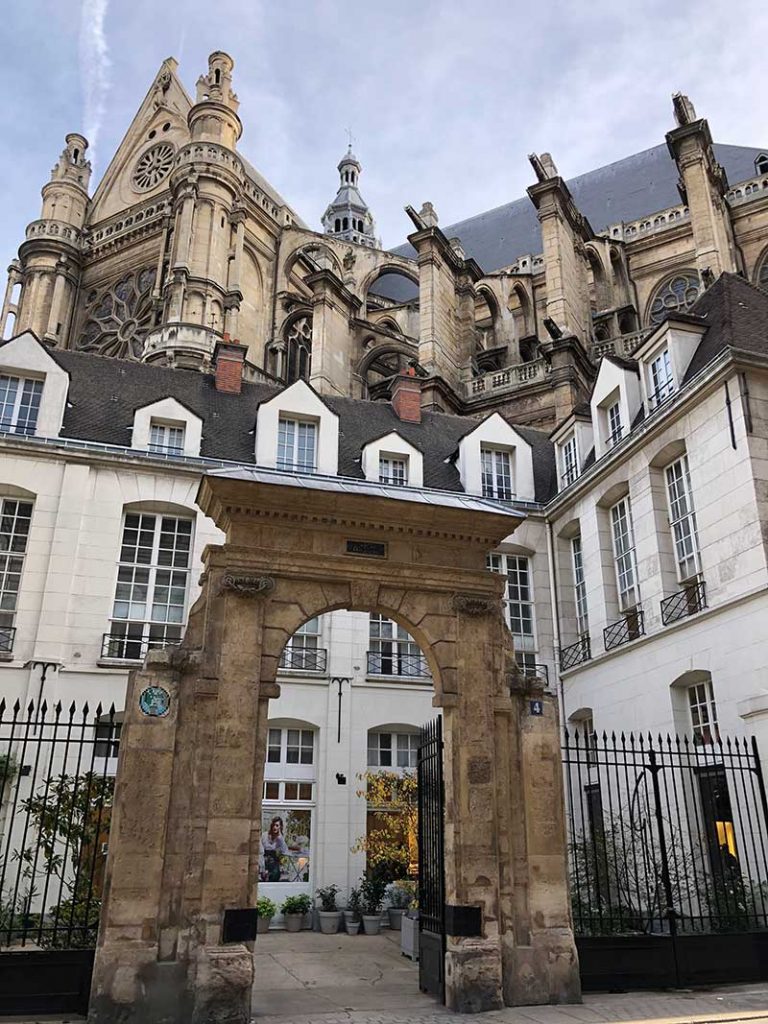
Paris by Robin Cobbey



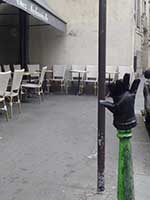 One encouraging trace of Nevada in modern day Paris is this representation of the iconic “Permanent Wave” by the late Doc Sherman of Baker. It is a brilliant addition to the artistic traditions of Paris and is being hurriedly added to the guidebooks.
One encouraging trace of Nevada in modern day Paris is this representation of the iconic “Permanent Wave” by the late Doc Sherman of Baker. It is a brilliant addition to the artistic traditions of Paris and is being hurriedly added to the guidebooks.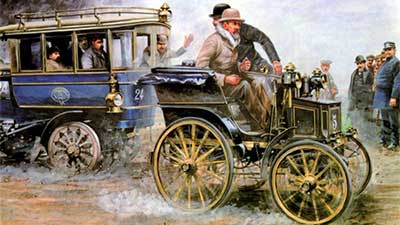
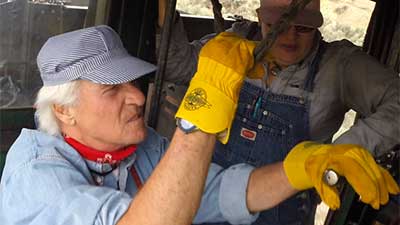
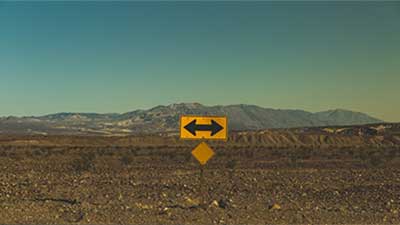
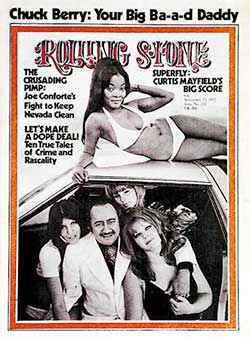 I had a telephone call from
I had a telephone call from 
